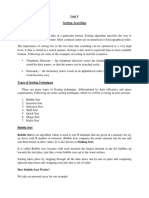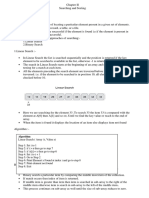Insertion Sort Algorithm
Uploaded by
adenoch113Insertion Sort Algorithm
Uploaded by
adenoch113DATA STRUCTURE - INSERTION SORT
http://www.tutorialspoint.com/data_structures_algorithms/insertion_sort_algorithm.htm
Copyright © tutorialspoint.com
This is a in-place comparison based sorting algorithm. Here, a sub-list is maintained which is
always sorted. For example, the lower part of an array is maintained to be sorted. A element which
is to be 'insert'ed in this sorted sub-list, has to find its appropriate place and insert it there. Hence
the name insertion sort.
The array is searched sequentially and unsorted items are moved and inserted into sorted sub-list
inthesamearray. This algorithm is not suitable for large data sets as its average and worst case
complexity are of Ο(n2 ) where n are no. of items.
How insertion sort works?
We take an unsorted array for our example.
Insertion sort compares the first two elements.
It finds that both 14 and 33 are already in ascending order. For now, 14 is in sorted sub-list.
Insertion sort moves ahead and compares 33 with 27.
And finds that 33 is not in correct position.
It swaps 33 with 27. Also it checks with all the elements of sorted sublist. Here we see that sorted
sub-list has only one element 14 and 27 is greater than 14. Hence sorted sub-list remain sorted
after swapping.
By now we have 14 and 27 in the sorted sublist. Next it compares 33 with 10,.
These values are not in sorted order.
So we swap them.
But swapping makes 27 and 10 unsorted.
So we swap them too.
Again we find 14 and 10 in unsorted order.
And we swap them. By the end of third iteration we have a sorted sublist of 3 items.
This process goes until all the unsorted values are covered in sorted sublist. And now we shall see
some programming aspects of insertion sort.
Algorithm
Now we have a bigger picture of how this sorting technique works, so we can derive simple steps
by which we can achieve insertion sort.
Step 1 − If it is the first element, it is already sorted. return 1;
Step 1 − Pick next element
Step 1 − Compare with all elements in the sorted sub-list
Step 1 − Find appropriate position
Step 1 − Insert the value
Step 1 − Repeat until list is sorted
Pseudocode
procedure insertionSort( A : array of items )
int holePosition
int valueToInsert
for i = 1 to length(A) inclusive do:
/* select value to be inserted */
valueToInsert = A[i]
holePosition = i
/*locate hole position for the element to be inserted */
while holePosition > 0 and A[i-1] > valueToInsert do:
A[holePosition] = A[holePosition-1]
holePosition = holePosition -1
end while
/* insert the number at hole position */
A[holePosition] = valueToInsert
end for
end procedure
To see insertion sort implementation in C programming language, please click here.
Loading [MathJax]/jax/output/HTML-CSS/jax.js
You might also like
- 24 - Data Structure and Algorithms Insertion SortNo ratings yet24 - Data Structure and Algorithms Insertion Sort6 pages
- Sorting Techniques: Stable and Not Stable SortingNo ratings yetSorting Techniques: Stable and Not Stable Sorting18 pages
- Data Structures-Sorting and Searching, HashingNo ratings yetData Structures-Sorting and Searching, Hashing35 pages
- In-Place Sorting and Not-In-Place SortingNo ratings yetIn-Place Sorting and Not-In-Place Sorting23 pages
- Data Structure Unit-6-Sorting_SearchingNo ratings yetData Structure Unit-6-Sorting_Searching16 pages
- CSE225L Sorting Algorithms: Selection SortNo ratings yetCSE225L Sorting Algorithms: Selection Sort8 pages
- Data Structures and Algorithms Bubble SortNo ratings yetData Structures and Algorithms Bubble Sort3 pages
- Chapter 10 Analysis of Sorting AlgorithmsNo ratings yetChapter 10 Analysis of Sorting Algorithms44 pages
- Introduction To Sorting: Practical Considerations For Internal SortingNo ratings yetIntroduction To Sorting: Practical Considerations For Internal Sorting2 pages
- CS20L: Information Structures Semester II, 2004 Sorting: DefinitionsNo ratings yetCS20L: Information Structures Semester II, 2004 Sorting: Definitions11 pages
- Data Structures and Algorithms MCQ Questions Set 02100% (1)Data Structures and Algorithms MCQ Questions Set 0241 pages
- Lecture 3 Search Strategies in Artificial IntelligenceNo ratings yetLecture 3 Search Strategies in Artificial Intelligence18 pages
- Objective Oriented Learning Process Format RBT (OLF) Branch: Semester: Subject Code & Title: Unit/Lesson No: T-L Tools: Faculty NameNo ratings yetObjective Oriented Learning Process Format RBT (OLF) Branch: Semester: Subject Code & Title: Unit/Lesson No: T-L Tools: Faculty Name9 pages
- The Chinese University of Hong Kong: Course Code: CSCI 2100A Final Examination 10f 2No ratings yetThe Chinese University of Hong Kong: Course Code: CSCI 2100A Final Examination 10f 22 pages
- Data Structure: Depth/Breadth-First SearchNo ratings yetData Structure: Depth/Breadth-First Search19 pages
- Chapter 11-Graphs and Their ApplicationsNo ratings yetChapter 11-Graphs and Their Applications50 pages
- Min Cost Flow and Succsesive Shortest Path AlgorithmNo ratings yetMin Cost Flow and Succsesive Shortest Path Algorithm18 pages
- Lab 08 Elementary Sorting Algorithms and Searching: Data Structures CS218 Instructor: Anam QureshiNo ratings yetLab 08 Elementary Sorting Algorithms and Searching: Data Structures CS218 Instructor: Anam Qureshi22 pages
- Unit-2: Searching, Sorting, Linked Lists: 2M QuestionsNo ratings yetUnit-2: Searching, Sorting, Linked Lists: 2M Questions34 pages
- Assignment No. 3: Title Aim/Problem StatementNo ratings yetAssignment No. 3: Title Aim/Problem Statement26 pages

























































































